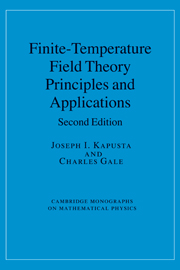Book contents
- Frontmatter
- Contents
- Preface
- 1 Review of quantum statistical mechanics
- 2 Functional integral representation of the partition function
- 3 Interactions and diagrammatic techniques
- 4 Renormalization
- 5 Quantum electrodynamics
- 6 Linear response theory
- 7 Spontaneous symmetry breaking and restoration
- 8 Quantum chromodynamics
- 9 Resummation and hard thermal loops
- 10 Lattice gauge theory
- 11 Dense nuclear matter
- 12 Hot hadronic matter
- 13 Nucleation theory
- 14 Heavy ion collisions
- 15 Weak interactions
- 16 Astrophysics and cosmology
- Conclusion
- Appendix
- Index
Conclusion
Published online by Cambridge University Press: 04 November 2009
- Frontmatter
- Contents
- Preface
- 1 Review of quantum statistical mechanics
- 2 Functional integral representation of the partition function
- 3 Interactions and diagrammatic techniques
- 4 Renormalization
- 5 Quantum electrodynamics
- 6 Linear response theory
- 7 Spontaneous symmetry breaking and restoration
- 8 Quantum chromodynamics
- 9 Resummation and hard thermal loops
- 10 Lattice gauge theory
- 11 Dense nuclear matter
- 12 Hot hadronic matter
- 13 Nucleation theory
- 14 Heavy ion collisions
- 15 Weak interactions
- 16 Astrophysics and cosmology
- Conclusion
- Appendix
- Index
Summary
In this book we have developed relativistic quantum field theory at finite temperature and density.We have studied extensively the theories of three of the four fundamental forces of nature: QED, QCD, and the Glashow–Weinberg–Salam theory of the weak interactions. In its nonrelativistic quantum mechanical guise, QED is responsible for the structure of atomic and molecular systems. Here we have focused on the properties of relativistic plasmas as realized in astrophysical environments. We have studied the screening of static electric charges, the propagation of collective excitations with the quantum numbers of the photon and the electron, shear and bulk viscosities, and thermal and electrical conductivities. We have also used the cold equation of state of dense electrons to calculate the masses and radii of white dwarf stars.
Spontaneous symmetry breaking is an important concept in both the strong and the electroweak interactions. When such symmetries are broken, the result is Goldstone bosons that reflect the underlying symmetry. In simple models illustrating this phenomenon, the spontaneously broken symmetry is restored at high enough temperatures, often via a second-order phase transition. An extension of these models to include gauge bosons reveals the Higgs mechanism, whereby one of the would-be Goldstone bosons combines with a gauge boson to produce a massive vector boson with three spin states. In simple enough models, this symmetry is restored at high temperatures.
QCD is the theory of quarks and gluons. We have studied it using perturbation theory and have found the limitations of the latter. The minimum extension is to sum the set of ring diagrams. This gives a contribution of order g3 to the pressure at high temperature.
- Type
- Chapter
- Information
- Finite-Temperature Field TheoryPrinciples and Applications, pp. 413 - 416Publisher: Cambridge University PressPrint publication year: 2006



